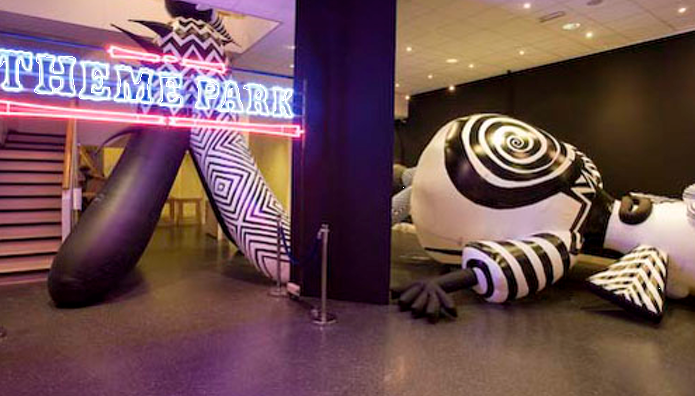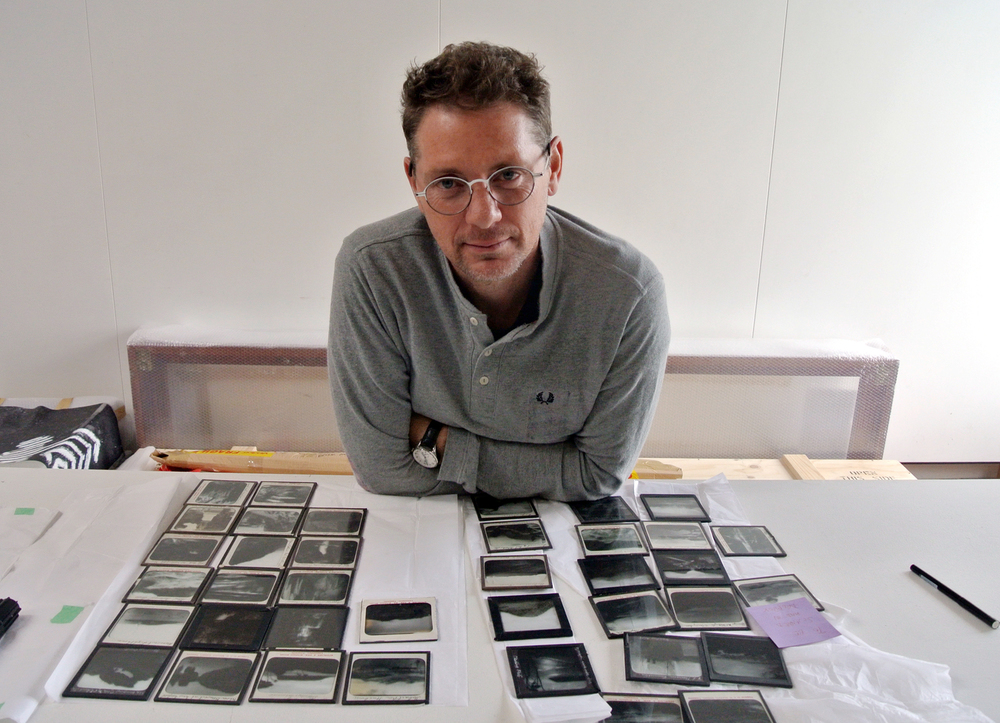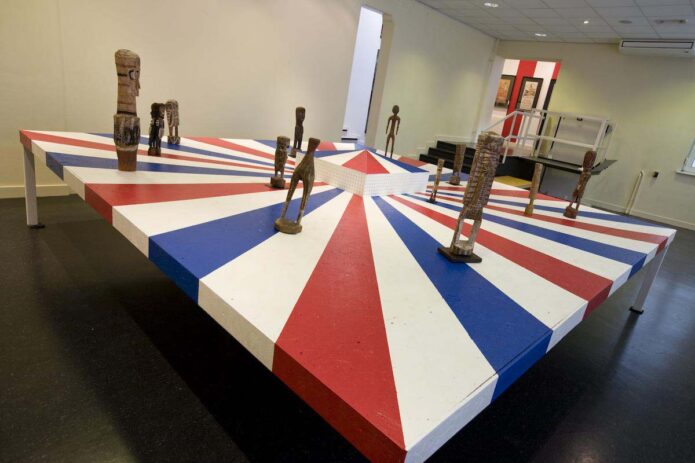 Brook Andrew, Theme Park (2008), AAMU - Museum voor hedendaagse Aboriginal kunst Utrecht
Brook Andrew, Theme Park (2008), AAMU - Museum voor hedendaagse Aboriginal kunst Utrecht Discussing The Frame: The Aboriginal Art Museum as Theme Park
The Aboriginal Art Museum in Utrecht has positioned itself as a leading institution promoting Aboriginal Art internationally. Until 19 April 2008, the space has been transformed into a Theme Park by artist Brook Andrew. The curator, Dr Georges Petitjean, gives an overview of the exhibition, and discusses the response of the Dutch audience.
“It was completely NOT what I expected. I even thought about asking for my money back. VERY BAD!!! The only nice thing (VERY NICE) was the gallery, but for the rest … quite disappointed.”
“Entered without expectations and was completely surprised by the metamorphosis. What a pleasing and stimulating final result! What an extraordinary project!”
The reactions in the visitors’ book for Brook Andrew’s exhibition project Theme Park speakvolumes. They alternate between enthusiastic congratulatory remarks to expressions of downright disappointment. What strikes one when browsing through the book is that most people have expressed feelings that this exhibition had not met their expectations: “Surprising!” and “Not what I expected” occur frequently in the comments. This is an exhibition that invokes controversy and conjures up opposing reactions. Indeed, the very point of departure of Theme Park has the potential to frustrate the expectations of many visitors. In this interactive exhibition project that occupies the entire building, Brook Andrew has subverted and redefined the role of the museum: it has become an object, and the subject of the exhibition. The artist has turned the museum itself into an exhibition project, exploring its own records and its own objects alongside objects added by Andrew, and the artist’s own work. Next to Australian shields, clubs and boomerangs from the collections of the Royal Museum for Central Africa (Tervuren, Belgium) and the Musee des Confluences (Lyon, France), one finds 17th-century Dutch maritime prints from the Rotterdam Maritime Museum, records and objects from Andrew’s own collection of Australiana and Aboriginalia, archival material, found objects and works by modern and contemporary European artists. The exhibition is a Gesamtkunstwerk – a total work in which coloured walls, customdesigned lightning, a highly unusual hang and accompanying music are part of the same intervention. Or, as one Dutch art critic put it: “A large, anarchistic multi-media installation.” I
In order to realise this controlled anarchy, Andrew adopted the strategy of a theme park, a roller coaster ride through the spaces of the museum. Several rooms represent themes that centre around identity, aesthetics, the politics of perception and the amnesia of history. On the ground level a tacky neon sign and two gigantic inflatable clowns lure the visitor inside. The clowns – one of which is standing on four legs with its head reaching up to the first floor while the other lays down in the sad impossibility of ever being able again to rise to its feet – are decorated with a black and white pattern that refers to Andrew’s Wiradjuri heritage.
These two Janus-faced clowns (one with a sad face, the other with a happy face) are typical of the ambiguity that runs through this “theme park”: deadly seriousness meets witty humour. As another reviewer for a Dutch art magazine noted: “Theme Park is misguiding. The spectacle of sound, objects and images has two faces and seizes you by the throat… It is the combination of playfulness, irony and humour versus the gravity and severe themes with drastic consequences that generates so much impact.”, This impact no doubt came about by the deconstruction and reconstruction of the museum in which Brook Andrew makes use of the colours red, black, yellow, white and blue. Apart from referring to both the Aboriginal and the Australian flag, they support the installations and objects in the different rooms of Theme Park.
The known as the Yellow Room. It features portraits of Aboriginal people – in photographs, on ceramic plates and on odd objects like barometers – next to works by Yirrwala, Marlene Dumas and Felix De Boeck. One particular work in this room, the representation of a Wandjina ancestor in pencil on paper, brilliantly illustrates the ambiguity and predicament of “Aboriginal art” as a label and hence subject to particular perceptions and expectations. While the artwork itself, through its subject matter, materials and unusual rendition of the Wandjina figure, can easily be overlooked as simply “Aboriginal art”, one’s attention is drawn to the strange wooden frame in which the work is presented. The frame dates from the 1950’s or 1960’s and is decorated with boomerangs, spears, stone axes, dots, snakes, concentric circles and platypuses. Aboriginal art and culture are all too often forced into a frame crafted to accommodate the wishes and anticipations of a misinformed audience.
Obviously, as can be deduced from the comments in the visitors’ book, this exhibition speaks volumes about the perceptions and expectations of visitors to this odd kind of museum. In its strategy of subversion, in which a mirror is held up (quite literally in the “yellow room”) to the spectator, Andrew confronts the spectator with his own racially motivated prejudices and assumptions. But what exactly is it that people do not expect when they enter this particular museum? What does the name “Aboriginal Art Museum” suggest to an international audience? Judging by some of the visitors’ comments, preconceived ideas about what constitutes Aboriginal art, culture and identity are strongly embedded in popular consciousness. A commonly heard comment is that they didn’t see “Aboriginal art”. 3 So do people expect to see what they perceive to be traditional Aboriginal art or artefacts? Ironically, more artworks and artefacts by Aboriginal people are on display in this exhibition than in any other previous exhibition at AAMU. But in Theme Park they are not displayed in a straightforward, readily recognisable museum display format. It was Brook Andrew’s masterstroke to show these objects in an innovative and surprising way. As much as this exhibition is a project that offers reflection on issues such as identity and racially influenced perceptions, it is also about exploring and suggesting other points of view. The museum-like display indeed forms a theme, and direct references to it occur in several of the installations: the Museum Cabinet installations, for example, and the Old Memory room, which deconstructs and questions common museum practices of the past. On the second floor several displays involve the presentation of culturally significant objects in a museum context and the story that is being told by this specific context. Quite often Andrews detaches or withdraws the object from the ethnographic context to give them a new setting, and perhaps to endow them with a new role and renewed power. Viewers are forced to look to be able to see. Perhaps then they will realise that they are themselves being viewed by the very subjects of their gaze. A good example of this new strategy of display is the installation Lost. Seventeen sculpted figures from the former Lance Bennett collection, now in a Dutch private collection, are displayed on a wooden platform in the shape of a circus tent and coloured in red, white and blue. The figures appear to be drawn to the centre of the display – a small construction from which can be heard the most famous songs by crooner Jimmy Little. Most of the figures on the platform are sculpted heads from Tiwi poles dating from the 1960s. As in other installations, music and song play an important role in Lost. The songs of Jimmy Little, as it were, sing the figures back to life, bring them back into the now. It is a reference to the importance of singing in Aboriginal culture. In another space on the second floor – the Mirror Ball Room – a number of bark paintings from Arnhem Land and the west Kimberley region are displayed with a mirror ball reflecting coloured speckles of light onto the artworks. Most of the paintings from Arnhem Land show male and female Namarnday spirits, some of which are involved in making love as a group. The reference to the disco and its social role in pairing potential sexual partners is powerful. The highly sexual content of some of the barks is reactivated and actualised. Elsewhere a photocopier is placed in front of a wall displaying black-and-white educational posters from the 1960s. The copier continually ejects copies of two photographs: late 19th-century portraits of the same beautiful young Aboriginal woman depicted in a Victorian summer dress but bare-chested. The repeated act of copying these photographs, which are in turn already copies of the original albumin prints, represents the physical and figurative degeneration that accompanies the conceptualisation of a sexualised exotic other into an image. On the photographs appear a German name (Carl Gunther) and city (Berlin). Were these pictures taken in Germany? What was the photographer’s relationship with the model? Answers to these questions remain a mystery. This exhibition indeed forces a reconsideration of preordained views. Andrew confronts the prejudices and stereotypes that have so long dominated – and still dominate – perceptions of Aboriginal people and their culture, especially when they become the subjects of vulgar amusement. Yet this project is not an aggressive statement inspired by political correctness. “In fact,” writes the Dutch art critic Paola van de Velde, “Theme Park is one large plea for tolerance, compassion and an open and free spirit.” 4 By including work by the Belgian artists Marcel Broodthaers and Felix De Boeck, Andrew recaptures and develops earlier discussions held in exhibitions at AAMU in which the work by Indigenous Australian was shown alongside European artists. These were aimed at exploring the notions of “Western” and “nonWestern” art, and the boundaries between peripheral and established art, thus linking up to international art historical debates in which the notion of “world art” and “otherness” playa significant role. In the current climate of art historical debate in regard to these issues, the museum is a well-placed platform from which to research and contribute to these topics through both exhibitions and the associated activities such as forum discussions and lectures. 5
Brook Andrew’s exhibition project is the provisional culmination of an exhibition programme at AAMU that endeavours to go far beyond that what is expected of an “Aboriginal Art Museum”. Indeed, the AAMU programme favours exhibitions that offer openness as part of an outspoken approach at presenting Indigenous Australian art as contemporary art, which is made in the here and now, in a contemporary art context. 6 This implies that the art is treated on equal terms. It is the task of AAMU to question and to investigate, to go beyond its self-imposed limitations and act, in the first instance, as a space in which to engage with contemporary art. This is its very validation of existence. But with this exhibition, Andrew subverts these notions; it is not so much the museum that is showing the work of Brook Andrew but Brook Andrew who is showing the work of the museum. This is a point on which Martijn van Nieuwenhuyzen, curator of the Stedelijk Museum in Amsterdam, elaborated during his thoughtprovoking opening speech for Theme Park on 30 October 2008. He mused on the question of what Brook Andrew was doing in an “Aboriginal Art museum”, and came to the irreversible conclusion that the artist had made a work that used deconstruction and de mystification to question the very notion of “Aboriginal art”. Van Nieuwenhuyzen expressed in his speech the prospect that Theme Park “will be a catalyst for the discussion in Utrecht on the idea of ‘Aboriginal art’ and a point of departure for reviewing and possibly redefining the museum policies and mission.”7 Andrew has asked the fundamental question: is there a need for a museum or gallery – or magazine – that focuses solely on Indigenous Australian art? And is such a focus desirable? It is a question that will continue to be asked.
Text by George Petitjean
This article was first published in Australian Aboriginal Art, March 2009
and reprinted with permission.
Notes
1 VANDE VELDE, Paola, Pretpark stemt niet vrolijk [Theme park doesn’t render joyful], in De Telegraaf, 21 November 2008 p. 117
2 DUKING, Karen, Bloedserieus pretpark [Dead serious theme park], in Lukas X, number I, January-february-March 2009, p.8
3 This was already the case with a previous exhibition held at AAMU, entitled Images, in which Brook’s work was included next to that ofTracey Moffatt, Destiny Deacon, Fiona Foley and other artists whose work was photography or video-based.
4 VANDE VELDE, Paola, Pretpark stemt niet vrolijk, in De Telegraaf, 21 November 2008, p. 117
5 See Kitty Zijlmans – ZIJLMANS, Kitty & VAN DAMME, Wilfried, World Art Studies: Exploring Concepts and Approaches, Valiz, Amsterdam, 2008. World Art Studies, a term which is borrowed from John Onians [is a neutral term that] implies that there are art objects and artefacts on the earth that can [are worth to] be studied and that thi s shouldn’t be confined to a designated geographical area (Kitty Zijlmans). World Art Studies form the basis of the renewed art history program at Leiden University.
6 PETITJEAN, Georges, The AAMU in Utrecht – a new focus for a museum for contemporary Aboriginal art, in Museum Aktue ll, nr 294- Augustus 2008, p.13-15
7 Martijn van Nieuwenhuyzen, unpublished speech, Utrecht, 30 October 2008
Contemporary Aboriginal art / Museology /
Agenda
Indigenous Art Now!
Forum and launch for Artlink Indigenous.
The View of Self - Blak on Blak
Blak on Blak - reading Australian blak art, myth and reality in perceptions of contemporary indigenous practice.
The View of the Artist
A panel discussion between artists and museum curators.
Network

Brook Andrew
artist

